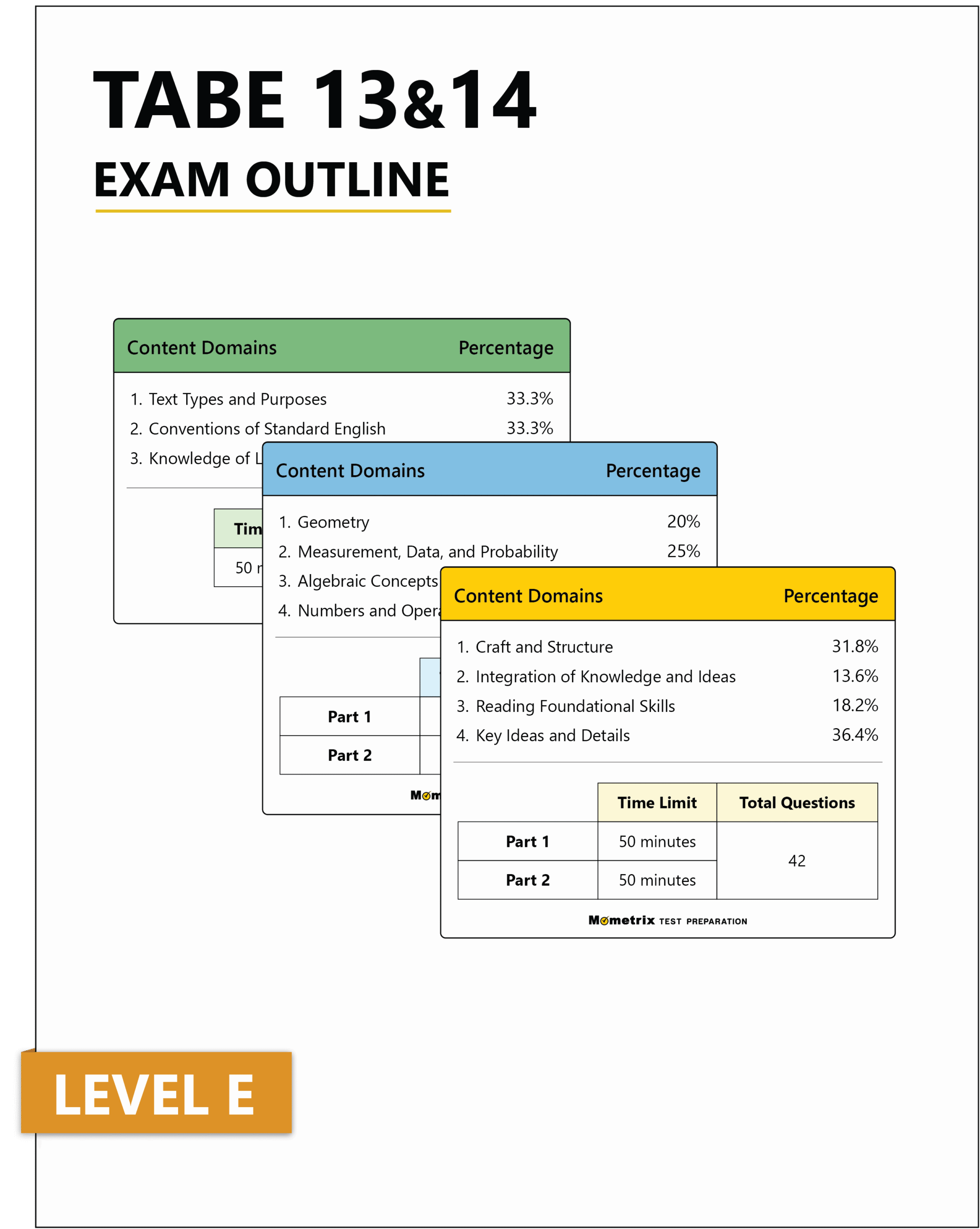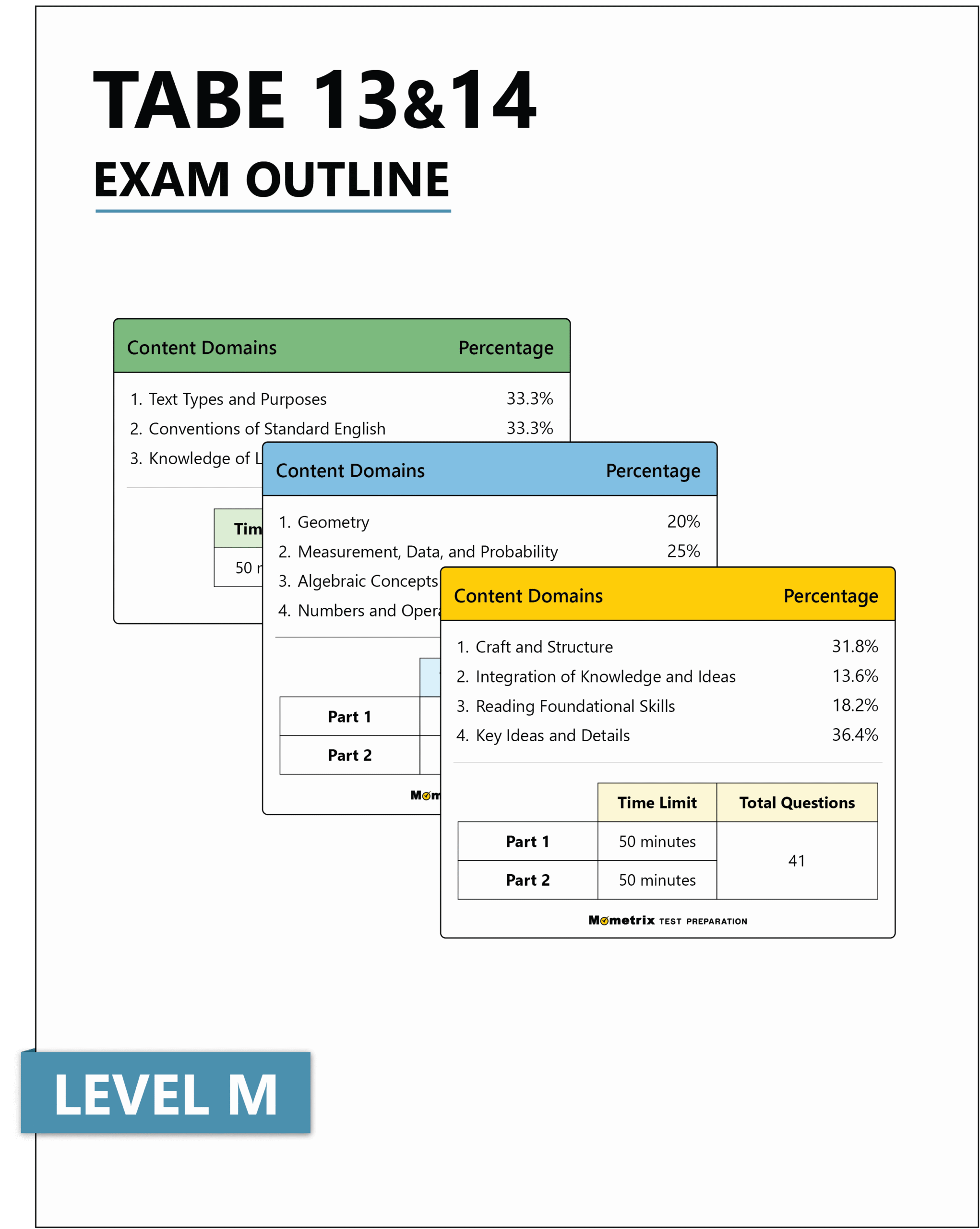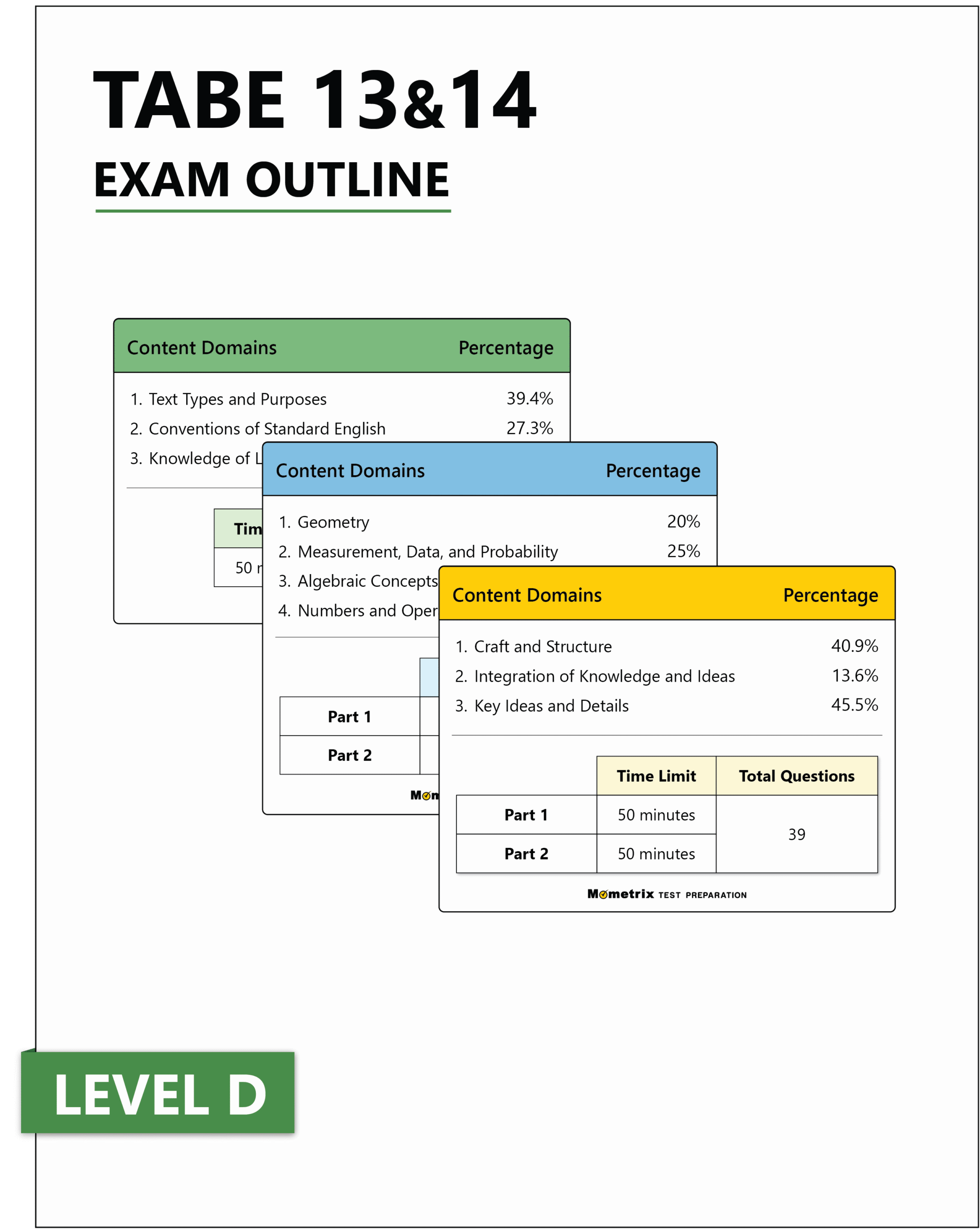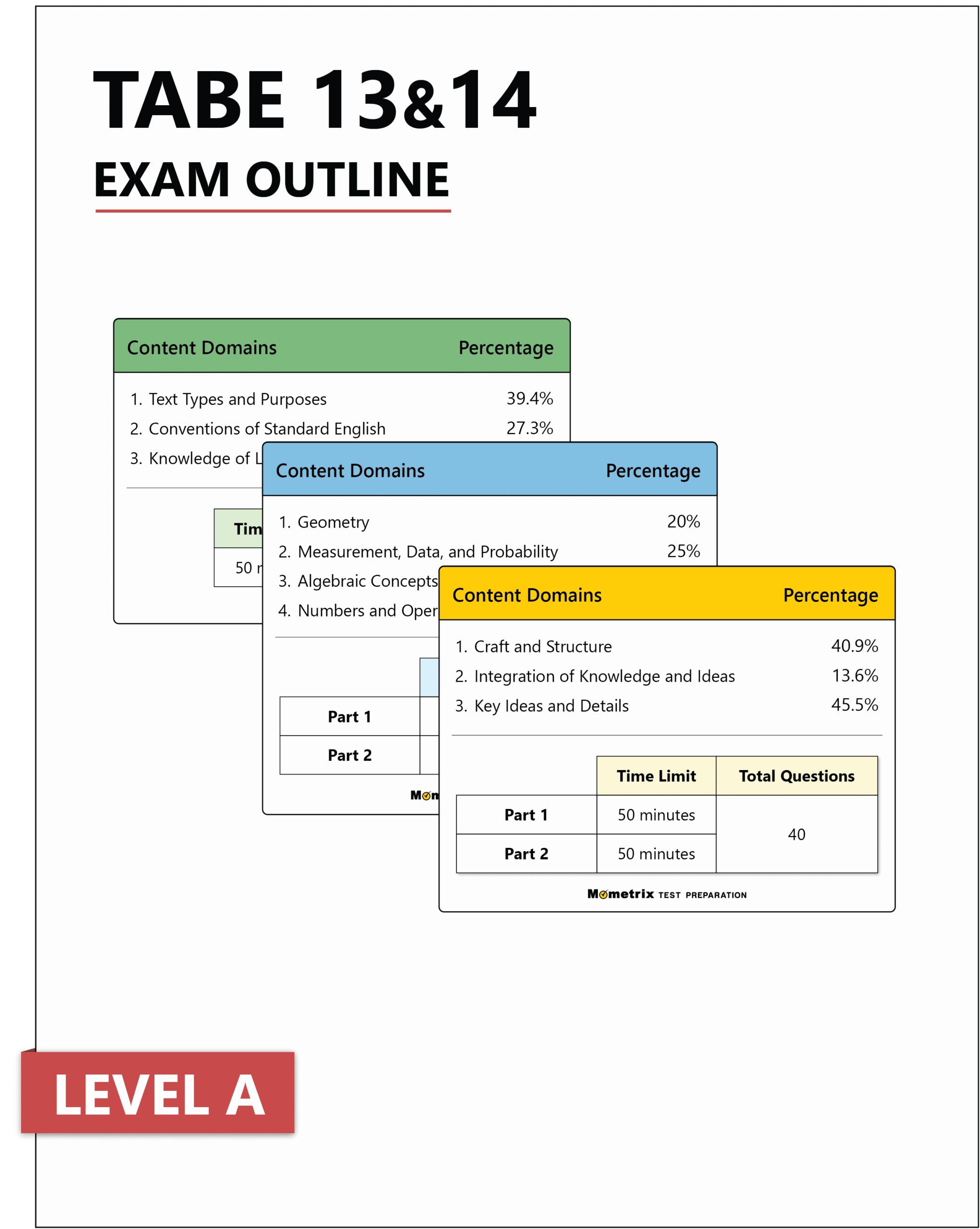Many of the educators and employers use the TABE® 13&14 test to gauge a person’s skill levels in various subjects. Getting a good score on the test can greatly impact your placement, training, and advancement in your education and career.
To make sure you’re prepared, check out our premium-quality TABE test prep resources by clicking the links below!
TABE 13&14 Test Outline
The test is broken up into three subjects: reading, mathematics, and language. You may end up taking all three subject tests, or you may only need to take one or two.
Each subject tests contains 33-42 questions, and two of the tests are split into two parts.
Before you take the exam, you’ll take a locator test, which identifies which testing level is best for you. The testing levels are Easy (E), Medium (M), Difficult (D), and Advanced (A). The contents of the exam are slightly different for each level. You can take a closer look at each level by clicking the outlines below.
Here’s a look at the topics found on each section of the exam:
Reading
The Reading section focuses on four main topics:
- Craft and structure
- Integration of knowledge and ideas
- Reading foundational skills
- Key ideas and details
You’ll be asked to do things like determine the meanings of words and phrases, compare and contrast points and details, apply grade-level phonics and word analysis, and describe relationships between ideas and concepts in a text.
Mathematics
The Mathematics section focuses on four main topics:
- Geometry
- Measurement, data, and probability
- Numbers and operations
- Algebraic concepts
You’ll be asked to do things like find the area of specific shapes, create and analyze line plots, write and evaluate expressions, and fluently divide multi-digit numbers.
Language
The Language section focuses on three main topics:
- Knowledge of language and vocabulary
- Conventions of standard English
- Text types and purposes
You’ll be asked to do things like write an opinion piece on a topic, demonstrate a command of spelling and punctuation, and demonstrate an understanding of figurative language.
Check Out Mometrix's TABE 13 and 14 Study Guide
Get practice questions, video tutorials, and detailed study lessons
Get Your Study Guide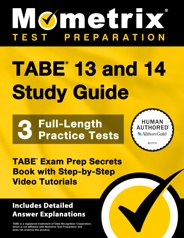
Study For the TABE the Best Way
How to Study Effectively
Your success on TABE test day depends not only on how many hours you put into preparing, but also on whether you prepared the right way. It’s good to check along the way to see whether your studying is paying off. One of the most effective ways to do this is by taking TABE practice tests to evaluate your progress. Practice tests are useful because they show exactly where you need to improve. Every time you take a free TABE practice test, pay special attention to these three groups of questions:
- The questions you got wrong
- The ones you had to guess on, even if you guessed right
- The ones you found difficult or slow to work through
This will show you exactly what your weak areas are, and where you need to devote more study time. Ask yourself why each of these questions gave you trouble. Was it because you didn’t understand the material? Was it because you didn’t remember the vocabulary? Do you need more repetitions on this type of question to build speed and confidence? Dig into those questions and figure out how you can strengthen your weak areas as you go back to review the material.
Answer Explanations
Additionally, many TABE practice tests have a section explaining the answer choices. It can be tempting to read the explanation and think that you now have a good understanding of the concept. However, an explanation likely only covers part of the question’s broader context. Even if the explanation makes sense, go back and investigate every concept related to the question until you’re positive you have a thorough understanding.
Comprehend Each Topic
As you go along, keep in mind that the TABE practice test is just that: practice. Memorizing these questions and answers will not be very helpful on the actual test because it is unlikely to have any of the same exact questions. If you only know the right answers to the sample questions, you won’t be prepared for the real thing. Study the concepts until you understand them fully, and then you’ll be able to answer any question that shows up on the test.
Check Out Mometrix's TABE 13 and 14 Flashcards
Get complex subjects broken down into easily understandable concepts
Get Your Flashcards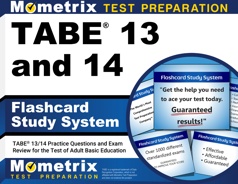
TABE 13&14 Online Prep Course
If you want to be fully prepared, Mometrix offers an online TABE 13&14 prep course designed to give you everything you need to succeed!
Here’s what you’ll find in the TABE 13&14 course:
Everyone learns differently, so we’ve tailored the TABE 13&14 online prep course to ensure every learner has what they need to prepare for the TABE 13&14 exam.
Click below to check it out!
TABE Practice Methods
When you’re ready to start taking TABE practice tests, follow this strategy:
- Remove Limitations. Take the first test with no time constraints and with your notes and TABE study guide handy. Take your time and focus on applying the strategies you’ve learned.
- Time Yourself. Take the second practice test “open book” as well, but set a timer and practice pacing yourself to finish in time.
- Simulate Test Day. Take any other practice tests as if it were test day. Set a timer and put away your study materials. Sit at a table or desk in a quiet room, imagine yourself at the testing center, and answer questions as quickly and accurately as possible.
- Keep Practicing. Keep taking practice tests on a regular basis until you run out of practice tests or it’s time for the actual test. Your mind will be ready for the schedule and stress of test day, and you’ll be able to focus on recalling the material you’ve learned.
If you need additional instruction, check out the Mometrix flashcards and study guide which includes additional practice tests. These invaluable resources include a risk-free, 1-year 100% money-back guarantee. Repetition and practice is key to adequate preparation.
FAQs
Q
How many questions are on the TABE 13&14 test?
A
Each subject tests contains 33-42 questions.
Q
How long is the TABE 13&14 test?
A
Each subject test has its own time limit. It you take all three tests together, the total time limit is 3.5 hours.
Q
What is the passing score for the TABE 13&14 test?
A
There isn’t a universal passing score for the test since it’s used as a placement test.
TABE is a registered trademark of Data Recognition Corporation, which is not affiliated with Mometrix Test Preparation and does not endorse this page.
